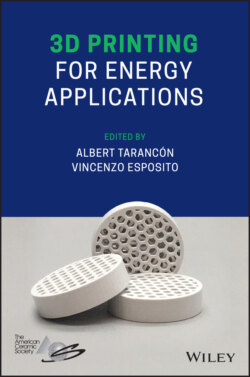Читать книгу 3D Printing for Energy Applications - Группа авторов - Страница 15
I.4 Scope of the Book
ОглавлениеLarge scientific and technical production in the field of 3D printing has risen in the last years. The fame of 3D printing comes from the actual power of the technique combined with its coverage in a broad range of applications. Such a potential is also boosted by the current viability of affordable 3D printers for consumers and prosumers, where the market often escorts the actual possibilities with the promise of revolutionizing the way we consume and create. This combination of factors has indeed created great expectations. However, for the advanced uses, 3D printing firmly refers to a complex chain of additive manufacturing procedures and, besides some exceptions, it relies on boundary interdisciplinary research. Form the scientific and technical point of views, the variety of the topics and the possibilities appear endless and often it results difficult to identify the real possibility.
In view of such preliminary considerations, in this book, we try to shade light on the real possibilities of 3D printing in one of the most charming opportunities opened by additive manufacturing methods: the energy field. To construct a critical discussion around this fascinating topic, we define in Part I the link between most recent advances in the field of additive manufacturing with functional materials to be used in the energy systems. Under such a frame, selected contributions with the typical material science approach, we introduce the three classes of materials used in 3D printing: polymers, metals, and ceramics. We also highlight the need of use combinations of materials; multi‐materials manufacturing is the key in energy systems and the actual potential and limits of manufacturing multifunctional materials. Such an approach is reviewed in Part II, with key contributions about consolidated techniques, hybrid printing technologies, and new opportunities in the field. We especially focus on 3D printing challenges for production of complex objects, suiting a wide range of energy systems devices, not only for functional parts but also for accessory components. Finally, elements of interdisciplinary and consideration on consolidated trends in the energy research field are reported in Part III, with key‐examples of 3D printing of energy devices. In this last section, we have selected some important cases covering both consolidated energy technologies, such as turbines, batteries, capacitors, solar and nuclear as well as emerging technologies (piezoelectric energy harvesting, electrochemical fuel cells, and thermoelectric energy generation), and environmental solutions (chemical conversion and CO2 capture) that bring the promise of clean and sustainable solutions for the environment.
We edited the book to address readers with different backgrounds and aims, including graduated students in the materials science and engineering, chemists, mechanical engineers interested in manufacturing methods but also for a wider readership, seeking in 3D new opportunities of research and business.
